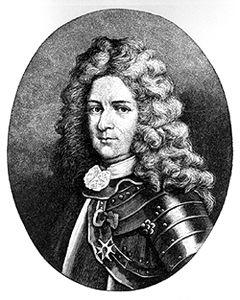Pierre Le Moyne d'Iberville et d'Ardillières, soldier, adventurer (baptised 20 July 1661 at Ville Marie [Montréal], New France; died probably on 9 July 1706 in Havana, Cuba). He was the third and most famous of Charles Le Moyne's 12 sons.

Various Military Expeditions
In 1686, Pierre Le Moyne d’Iberville et d’Ardillières joined the expedition led by de Pierre de Troyes against the English in James Bay. He was rewarded with the governorship of the conquered trading posts. He returned to the bay in 1688, 1690 and 1694. There, he raided English posts and seized furs. On 5 September 1697, his lone ship Pélican defeated three English warships near York Factory. The third ship had to escape. D’Iberville’s own ship was fatally damaged and sunk. (See York Factory and the Battle of Hudson Bay.)
Iberville's fierce courage and ruthlessness were forged in a context of desperate colonial competition and savage border wars. In 1690, he took part in a brutal guerrilla attack on Corlaer, New England. During the attack, some 60 settlers were massacred. In 1696–97, he led militia, Indigenous warriors and French soldiers on a rampage across Newfoundland. They burned, looted and killed some 200 men. In 1698–99, 1699–1700 and 1701–02, Iberville commanded expeditions to Louisiana. He helped establish Forts Maurepas, Mississippi, Saint-Louis (Old Mobile). He collected furs and negotiated with Indigenous peoples.
Iberville's last campaign in 1706 was clouded by controversy. He ruthlessly plundered the English colony of Nevis in the West Indies. Iberville died that year, likely of yellow fever. However, he was nonetheless convicted of various charges, including illegal trading. As such, most of his estate was seized in reparation.
Legacy
Pierre Le Moyne d’Iberville’s career was an uneasy mixture of commercial ambition and military zeal. His conquests were often short-termed and his actions often cruel. However, his daring inspired admiration even among his enemies. He was the first native-born Canadian to receive the Croix de Saint Louis (1699), for valour.

 Share on Facebook
Share on Facebook Share on X
Share on X Share by Email
Share by Email Share on Google Classroom
Share on Google Classroom

